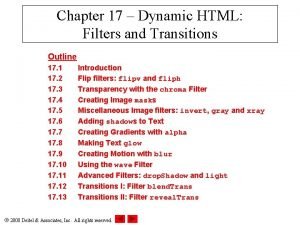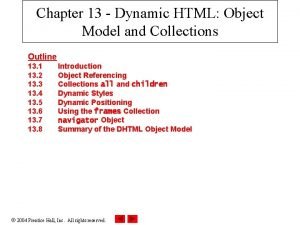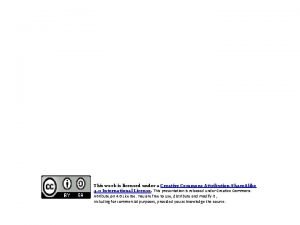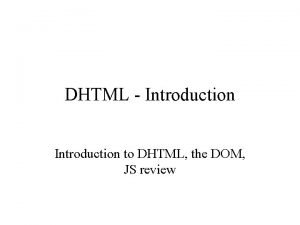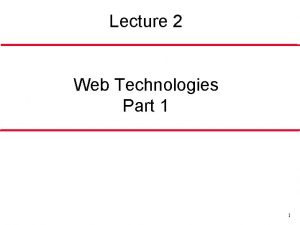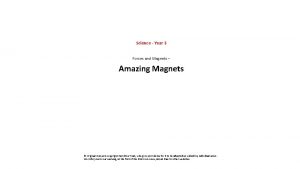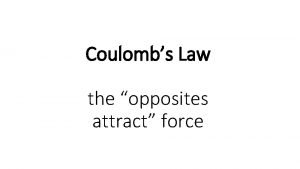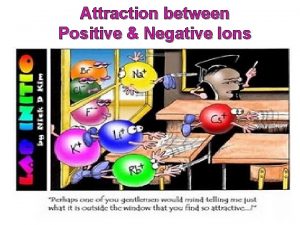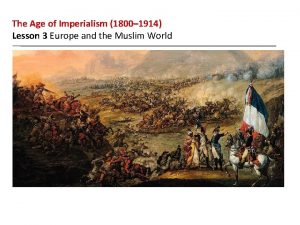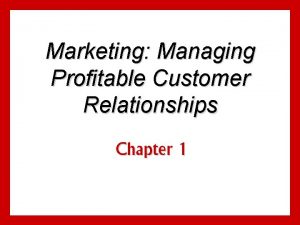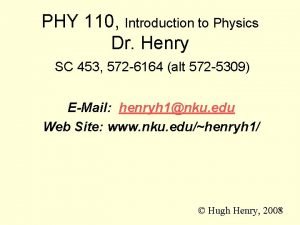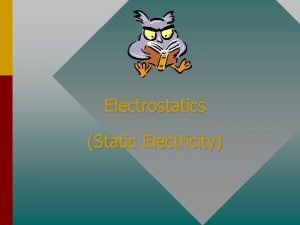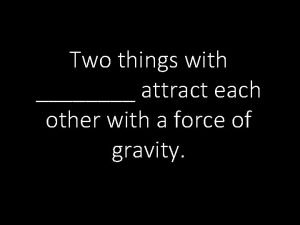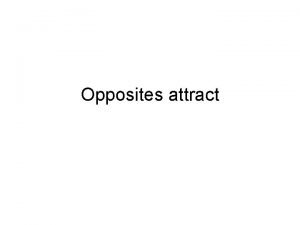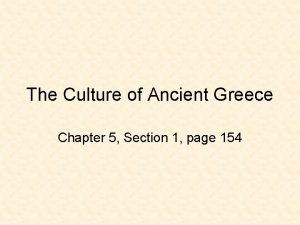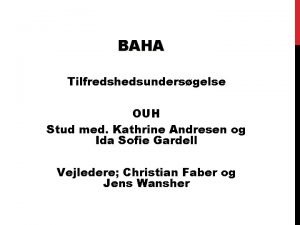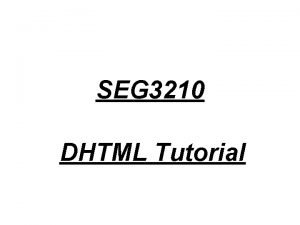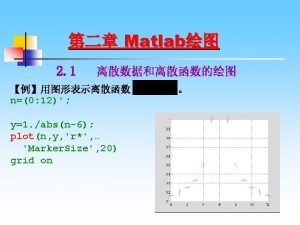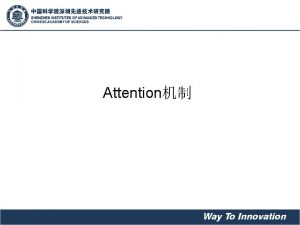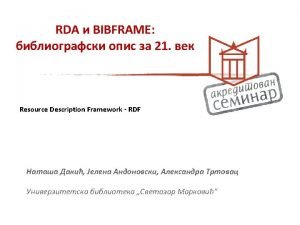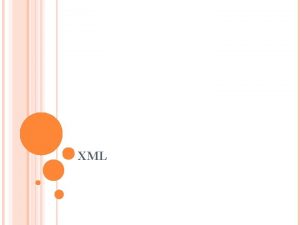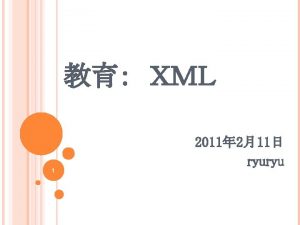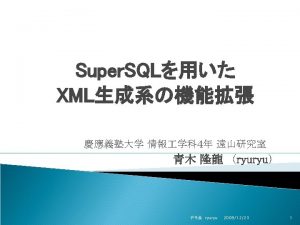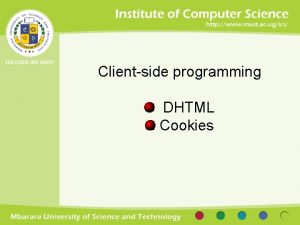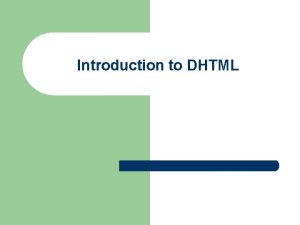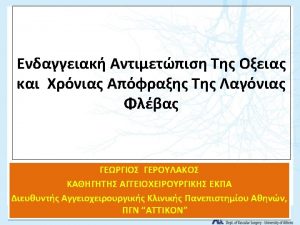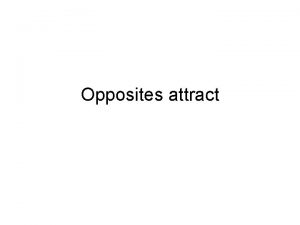DHTML XML DHTML Hold attention and attract users



































- Slides: 35

DHTML & XML

DHTML Hold attention and attract users to come back Eye-catching graphics Interactive and animated --> combining HTML with a scripting language and/or stylesheet "Dynamic HTML is a term used by some vendors to describe the combination of HTML, style sheets and scripts that allows documents to be animated. “ - W 3 C Is not a language

DHTML Object Model Object model allows web authors to: Control the presentation of their pages Gives them access to all elements on their Web page The whole web page (elements, forms, tables, frames etc. ) is represented in an object hierarchy

Object Referencing Simplest way to reference an element: id attribute Element is represented as an object Its various (X)HTML attributes become properties Properties can be manipulated by scripting Example: inner. Text

<html> <head> <title>Object Model</title> <script type = "text/javascript"> <!-function start() { alert( p. Text. inner. Text ); p. Text. inner. Text = "Thanks for coming. "; } // --> </script> </head> <body onload = "start()"> <p id = "p. Text">Welcome to our Web page!</p> </body> </html>


Collections: all and children all = a collection (array) of all the (X)HTML elements in a document, in the order in which they appear children = a collection for a specific element that contains that element’s child elements (direct descendants)

<html> <head> <title>Object Model</title> <script type = "text/javascript"> <!-var elements = ""; function start() { for ( var loop = 0; loop < document. all. length; ++loop ) elements += " " + document. all[ loop ]. tag. Name; p. Text. inner. HTML += elements; } // --> </script> </head> <body onload = "start()"> <p id = "p. Text">Elements on this Web page: </p> </body> </html>


<html> <head> <title>Object Model</title> <script type = "text/javascript"> <!-var elements = "<ul>"; function child( object ) { var loop = 0; elements += "<li>" + object. tag. Name + "<ul>"; } // --> </script> </head> <body onload = "child( document. all[ 4 ] ); my. Display. outer. HTML += elements; my. Display. outer. HTML += '</ul>'; "> <p>Welcome to our <strong>Web</strong> page!</p> <p id = "my. Display"> Elements on this Web page: </p> for ( loop = 0; loop < object. children. length; loop++ ) { </body> if ( object. children[ loop ]. children. length ) </html> child( object. children[ loop ] ); else elements += "<li>" + object. children[ loop ]. tag. Name + "</li>"; } elements += "</ul>" + "</li>";


Dynamic Styles: using user response to change style <html> <head> <title>Object Model</title> <script type = "text/javascript"> <!-function start() { var input. Color = prompt( "Enter a color name for the " + "background of this page", "" ); document. body. style. background. Color = input. Color; } // --> </script> </head> <body onload = "start()"> <p>Welcome to our Web site!</p> </body> </html>


Event Model Scripts can respond to user interactions and change the page accordingly Mouse movements Keystrokes Content becomes more dynamic while interfaces become more intuitive

Event on. Click One of the most common events When user clicks a specific item with the mouse, the onclick event fires

<html> <head> <title>DHTML Event Model - onclick</title> <!-- The for attribute declares the script for --> <!-- a certain element, and the event for a --> <!-- certain event. --> <script type = "text/javascript" for = "para" event = "onclick"> <!-alert( "Hi there" ); // --> </script> </head> <body> <!-- The id attribute gives a unique identifier --> <p id = "para">Click on this text!</p> <!-- You can specify event handlers inline --> <input type = "button" value = "Click Me!" onclick = "alert( 'Hi again' )" /> </body> </html>


Other Events window. onerror <body onmousemove = “call function()”> onmouseover and onmouseout ---> Rollovers onfocus and onblur ---> Form processing

Filters and Transitions Transitioning between pages Random dissolves, horizontal/vertical blinds Make letters glow, drop shadows or blur Flip text horizontally or vertically Transparency effects Specified using CSS filter property

XML e. Xtensible Markup Language Open technology for electronic data exchange and storage Derived from SGML (Standard Generalized Markup Language) Contains only data, not formatting instructions Each application that process the XML data can display it/manipulate it differently Stylesheet: XSL Permits authors to create entirely new markup languages for describing data

Other XML-related Technologies Xpath: a language for accessing parts of an XML document XSL-FO: an XML vocabulary used to describe document formatting XSLT: a language for transforming XML documents

Processing an XML document XML parser (XML processor) Check an XML document’s syntax and enable software programs to process marked-up data Support the Document Object Model (DOM) or Simple API for XML (SAX) DOM-based parsers build tree structures containing XML document data in memory SAX-based parsers process XML documents and generate events that contain data from the XML document

XML Document Structure To define the proper structure of the XML document DTD (Document Type Definition) XML Schema When an XML document references a DTD or a schema, parsers read the DTD/schema and check whether the XML document is valid Well-formed is a must before validation These parsers are called validating parsers

XML Namespaces To prevent naming collisions Example: <subject>Math</subject> <subject>Wound Infection</subject> Becomes: <school: subject>Math</school: subject> <medical: subject>Wound Infection</medical: subject> school and medical are namespace prefixes

XML Namespaces Each namespace prefix has a corresponding URI (Uniform Resource Identifier) that uniquely identifies the namespace A URI can refer to a document, resource or anything on the Web URI is not URL is a path to a file on the WWW URI is simply a name

DTD Uses EBNF (Extended Backus-Naur Form) grammar * = 0 or more + = 1 or more ? = 0 or 1 The order of elements matter CDATA = character data --> will be passed to the application “as is” PCDATA = Parsed Character data (text), no markup characters

<!ELEMENT letter ( contact+, salutation, paragraph+, closing, signature )> <!ELEMENT contact ( name, address 1, address 2, city, state, zip, phone, flag )> <!ATTLIST contact type CDATA #IMPLIED> <!ELEMENT name ( #PCDATA )> <!ELEMENT address 1 ( #PCDATA )> <!ELEMENT address 2 ( #PCDATA )> <!ELEMENT city ( #PCDATA )> <!ELEMENT state ( #PCDATA )> <!ELEMENT zip ( #PCDATA )> <!ELEMENT phone ( #PCDATA )> <!ELEMENT flag EMPTY> <!ATTLIST flag gender (M | F) "M"> <!ELEMENT salutation ( #PCDATA )> <!ELEMENT closing ( #PCDATA )> <!ELEMENT paragraph ( #PCDATA )> <!ELEMENT signature ( #PCDATA )>

W 3 C XML Schema Uses a syntax similar to XML

<schema xmlns = "http: //www. w 3. org/2001/XMLSchema" xmlns: deitel = "http: //www. deitel. com/booklist" target. Namespace = "http: //www. deitel. com/booklist"> <element name = "books" type = "deitel: Books. Type"/> <complex. Type name = "Books. Type"> <sequence> <element name = "book" type = "deitel: Single. Book. Type" min. Occurs = "1" max. Occurs = "unbounded"/> </sequence> </complex. Type> <complex. Type name = "Single. Book. Type"> <sequence> <element name = "title" type = "string"/> </sequence> </complex. Type> </schema>

DOM Document Object Model A hierarchical tree structure of a document Each tag name is a node A node that contains other nodes (called children or child nodes) is called a parent node. Sibling nodes Descendant nodes Ancestor nodes

DOM Node object methods get. Parent. Node get. Node. Value get. First. Child get. Next Sibling get. Attributes insert. Before get. Elements. By. Tag. Name

XSL Specifies how programs should render XML document data Group of 3 technologies: XSL-FO (Formatting Objects) �PDF, plain text (paper printing oriented) XSLT (Transformations) �transforming XML into other formats Xpath --> syntax for accessing parts of an XML document XML and XSL’s relationship is similar to HTML and CSS

XSLT Transforming using XSLT involves two tree structures Source tree (the XML source doc) Result tree (the XML or HTML document to be created) XPath is used to locate parts of the source tree document that match templates defined in the XSL stylesheet Navigation is selected!

XPath Example <? xml version="1. 0" encoding="ISO-8859 -1"? > Select all the titles: /bookstore/book/title <bookstore> <book category="COOKING"> <title lang="en">Everyday Italian</title> <author>Giada De Laurentiis</author> <year>2005</year> <price>30. 00</price> </book> <book category="CHILDREN"> <title lang="en">Harry Potter</title> <author>J K. Rowling</author> <year>2005</year> <price>29. 99</price> </book> <book category="WEB"> <title lang="en">Learning XML</title> <author>Erik T. Ray</author> <year>2003</year> <price>39. 95</price> </bookstore> Select the title of the first book: /bookstore/book[1]/title Select price nodes with price>35: /bookstore/book[price>35]/price

<? xml version="1. 0" encoding="ISO-8859 -1"? > <bookstore> <book category="COOKING"> <title lang="en">Everyday Italian</title> <author>Giada De Laurentiis</author> <year>2005</year> <price>30. 00</price> </book> <book category="CHILDREN"> <title lang="en">Harry Potter</title> <author>J K. Rowling</author> <year>2005</year> <price>29. 99</price> </bookstore> Exercise: Create a DTD from this XML
 Michelle benjamin phd
Michelle benjamin phd Vertical blinds
Vertical blinds Object model and collections in dhtml
Object model and collections in dhtml Dhtml stands for
Dhtml stands for Dhtml introduction
Dhtml introduction Is dhtml new language explain shortly
Is dhtml new language explain shortly Dhtml form
Dhtml form Nn webklient
Nn webklient Dhtml
Dhtml Opposites attract magnets
Opposites attract magnets Magnets attract and repel
Magnets attract and repel Homeostasis motivation
Homeostasis motivation Which universal force can repel as well as attract?
Which universal force can repel as well as attract? An atom's ability to attract electrons
An atom's ability to attract electrons Opposite charges attract.
Opposite charges attract. Opposites attract law
Opposites attract law Why did christianity attract so many followers?
Why did christianity attract so many followers? Electron dot structure of magnesium fluoride
Electron dot structure of magnesium fluoride For which reason did persia attract foreign
For which reason did persia attract foreign The twofold goal of marketing is to attract new customers
The twofold goal of marketing is to attract new customers Particles attract each other
Particles attract each other Which universal force can repel as well as attract
Which universal force can repel as well as attract Qxa=e
Qxa=e Like charges attract or repel
Like charges attract or repel Wet cell
Wet cell The struggle among sellers to attract consumers
The struggle among sellers to attract consumers Like charges attract or repel
Like charges attract or repel Like charges attract or repel
Like charges attract or repel Things that attract each other
Things that attract each other Which diagram shows magnets that will attract each other?
Which diagram shows magnets that will attract each other? Why do opposites attract chemistry
Why do opposites attract chemistry Why did the city of alexandria attract scholars
Why did the city of alexandria attract scholars Dynamics 365 for talent onboard
Dynamics 365 for talent onboard Attract new customers by promising superior value
Attract new customers by promising superior value The struggle among sellers to attract consumers
The struggle among sellers to attract consumers Baha attract
Baha attract

